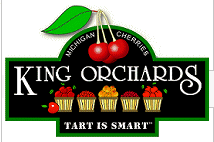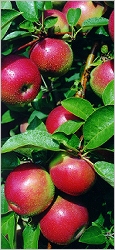 |
home > > about us >> high density
Modern Fruit Farming
High Density Apple Orchard
Apple orchards with trees planted close together on dwarfing or size-controlling rootstocks are referred to as high density plantings.
(photos by M. Berst at King Orchards, 1998-2003) |
| By using size-controlling rootstocks, we are able to increase tree densities dramatically. From this we achieve a higher yield per acre, better fruit quality, and earlier production which, of course, means a quicker return on our investment. |

Looking down between rows |
| With this slender, spindle-type training system we use, the trees need to have a permanent support system to ensure fast growth and give the tree adequate support for heavy fruit loads. The main support is a 10-ft-long piece of conduit or galvanized pipe 1 inch in diameter placed 6 inches away from each tree and driven 2 ft into the ground, linked by a trellis system with high tensile wire. The end of each row is anchored by a large pole (right) and the trees are tied loosely to the wires. |
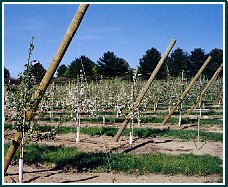
anchor poles |
The fruit on these trees is appearing 2-3 years sooner than on traditional plantings and the yield is 2-3 times more fruit per acre. The advantages for the grower can not be overstated, but there is also a significant social value to intensive agriculture.
see -- The relationship between high-yield farming and conservation read more >>
|
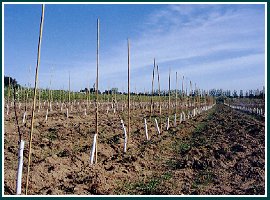
new trees |
| Another advantage from high density plantings: these trees can be trained, pruned, and harvested from ground level. This delivers important benefits in safety and lower labor costs, and more efficient resource management. High density planting is a part the global "green revolution" which is an international effort to grow food more efficiently and with less impact on the natural environment.
|
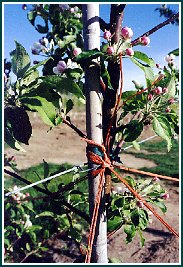
the trees are anchored to stakes |
| We are growing Gala, Ginger Gold, McIntosh and Red Delicious apples in this orchard and are enthusiastic about this modern fruit farming technique.
(right) This close-up photo shows how the high tensile wire is anchored to the poles at the end of each row of trees.
|
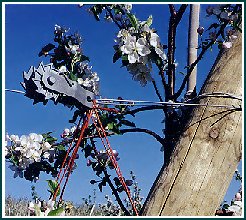 |
"From long before Malthus until about forty-five years ago each person took more land from nature than his parents did. For the past forty-five years people have been taking less land from nature than their parents."
Paul Waggoner - Connecticut Agricultural Experiment Station
The Green Revolution
excerpted from "Forgotten Benefactor of Humanity" by Gregg Easterbrook in The Atlantic Monthly, January 1997.
To Nobel Peace Prize winner Norman Borlaug, the argument for high-yield cereal crops, inorganic fertilizers, and irrigation became irrefutable when the global population began to take off after the Second World War. But many governments of developing nations were suspicious, partly for reasons of tradition (wheat was then a foreign substance in India) and partly because contact between Western technical experts and peasant farmers might shake up feudal cultures to the discomfort of the elite classes. Meanwhile, some commentators were suggesting that it would be wrong to increase the food supply in the developing world: better to let nature do the dirty work of restraining the human population.
Yet statistics suggest that high-yield agriculture brakes population growth rather than accelerating it, by starting the progression from the high-birth-rate, high-death-rate societies of feudal cultures toward the low-birth-rate, low-death-rate societies of Western nations. As the former Indian diplomat Karan Singh is reported to have said, "Development is the best contraceptive." In subsistence agriculture children are viewed as manual labor, and thus large numbers are desired. In technical agriculture knowledge becomes more important, and parents thus have fewer children in order to devote resources to their education.
|
|
